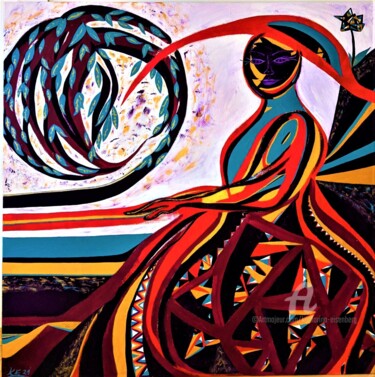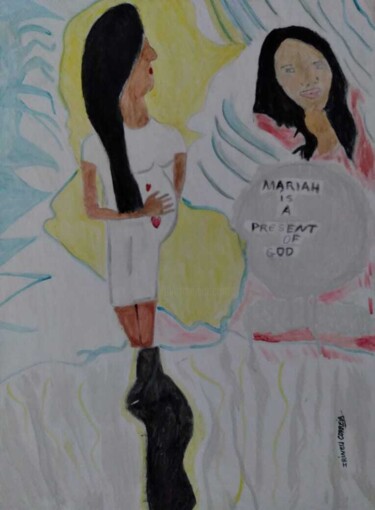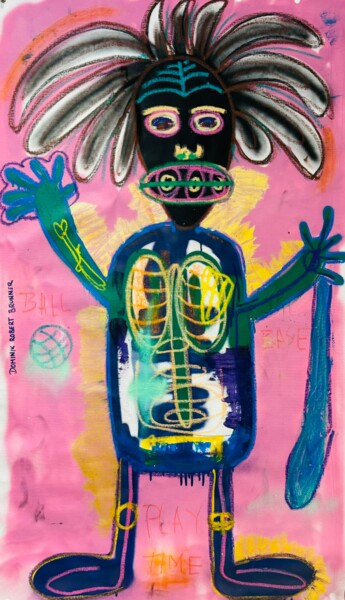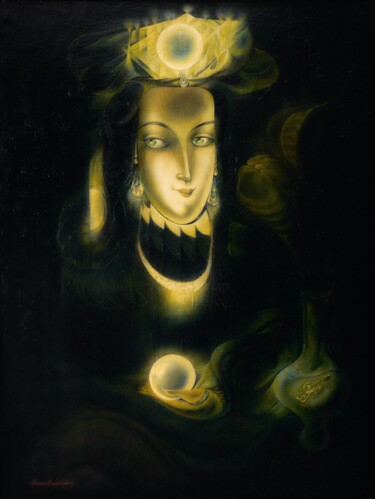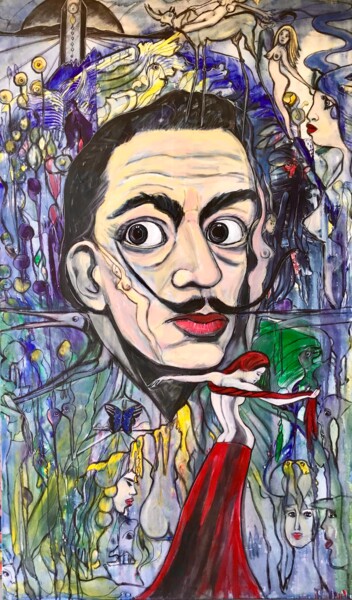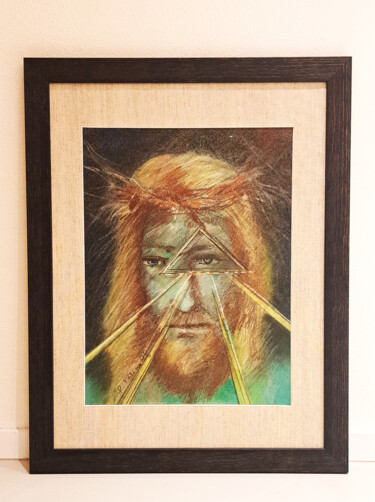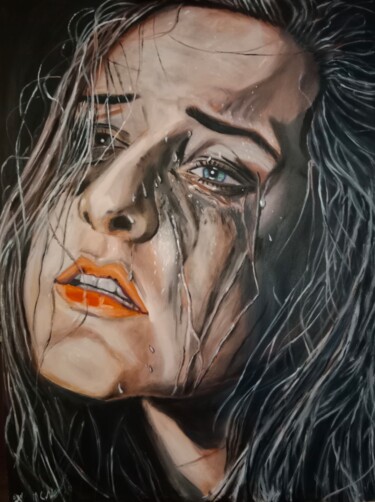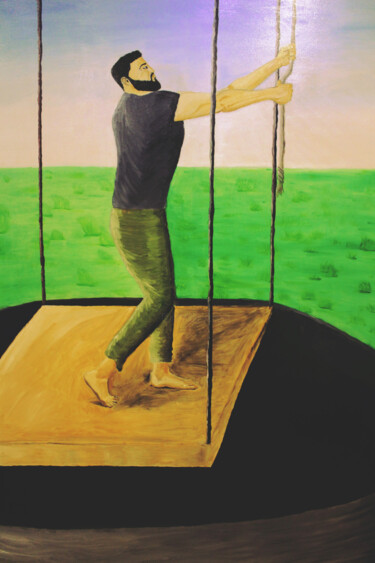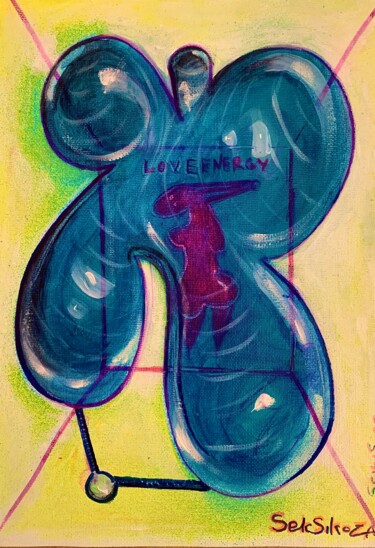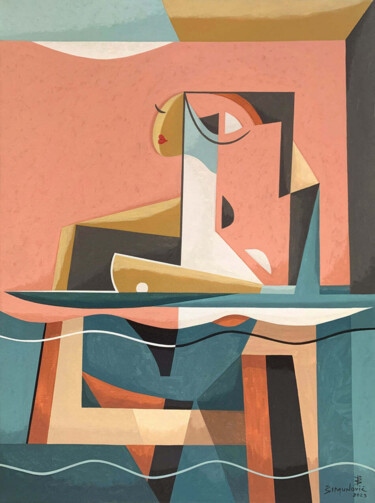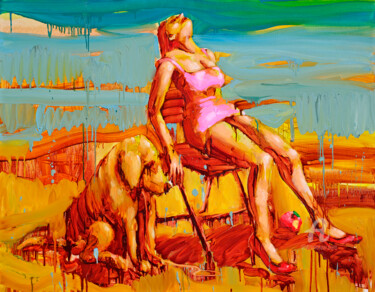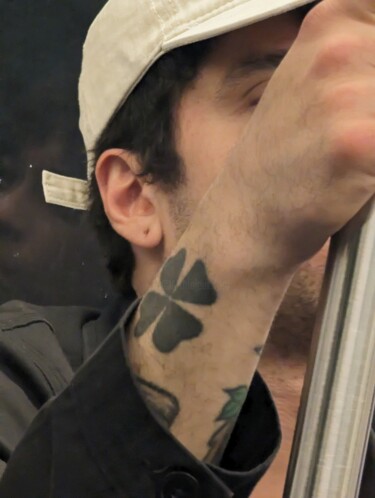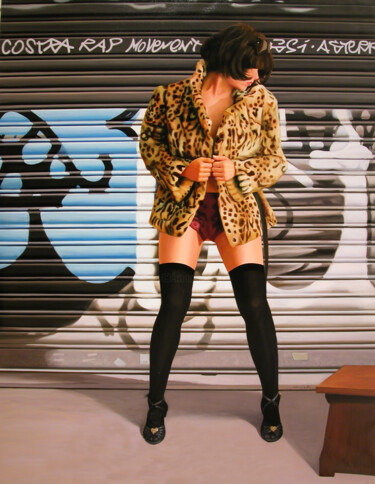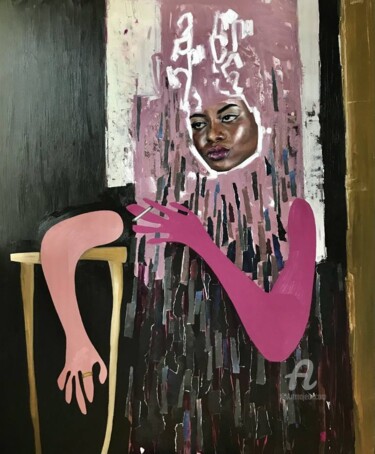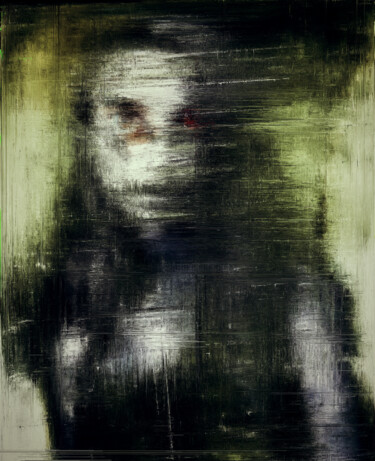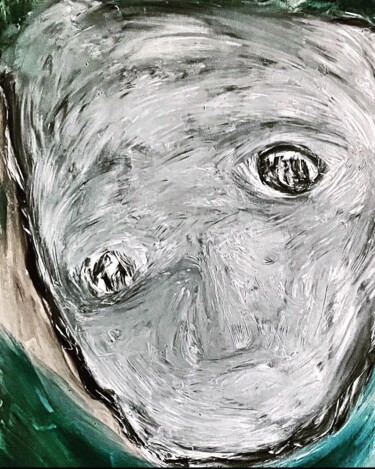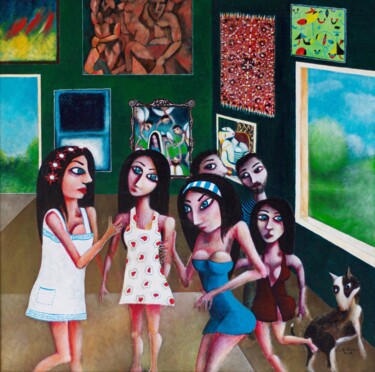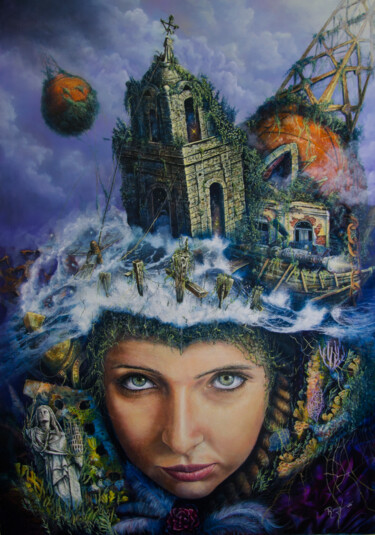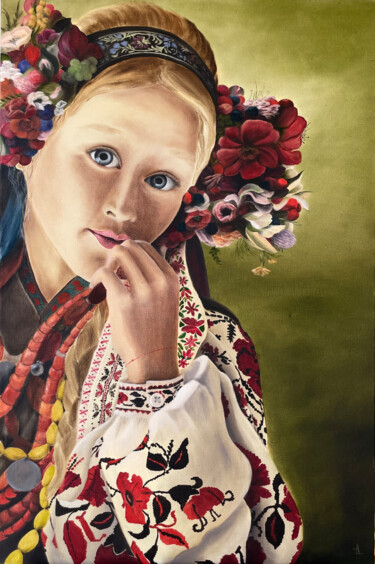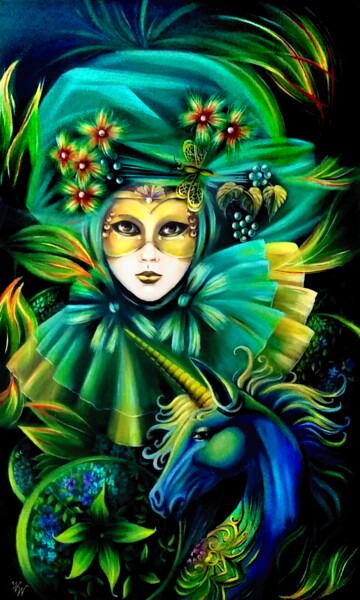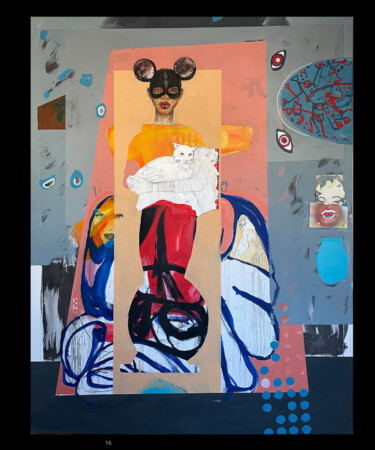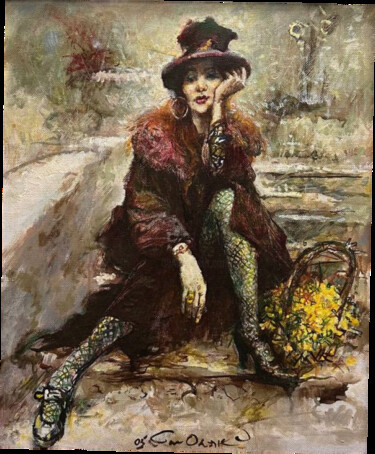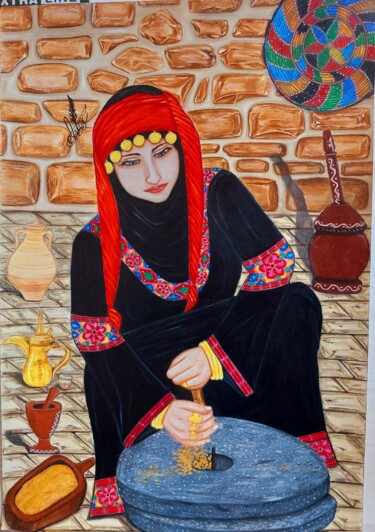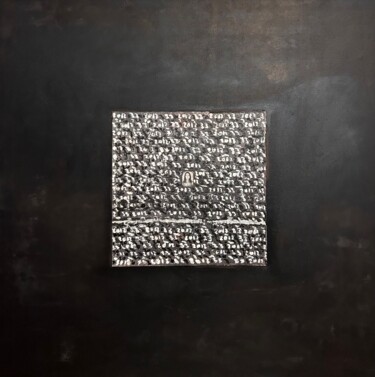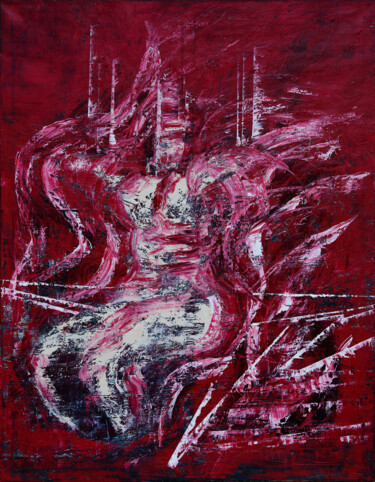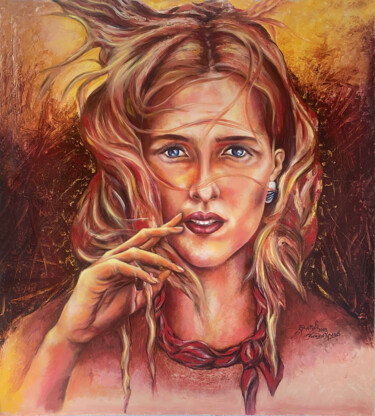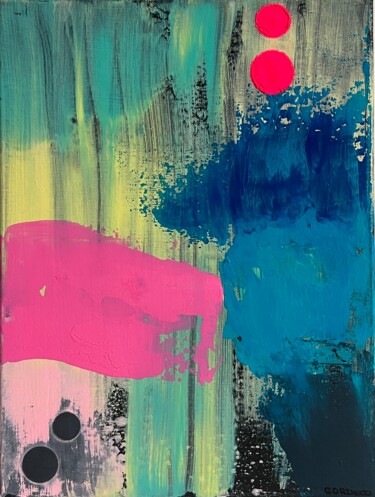82 Original Paintings For Sale:
Buying artworks on the theme of "Portrait"
Whether female or male, the portrait is a kind of painting that inspired painters from antiquity to the present day. Indeed, long before the appearance of the camera, the portrait was the only option to obtain the physical representation of a person. Portrait painting has therefore always been an exercise of choice to test the artist's talent. the portrait painter is a master in drawing with precision the delicacy of the facial features, represents the emotions through a palette of faithfully transcribed expressions, and respects the proportions of the model. Among the famous portraits in painting, let us note for example of course the famous "Mona Lisa" by Leonardo da Vinci, "The desperate" by Gustave Courbet or "The self-portrait with a felt hat" by Vincent van Gogh.
Looking for Original paintings for sale?
Explore all styles and all painting techniques: contemporary paintings, street art, abstract art, figurative art, landscapes, portraits, still lifes, nudes, watercolor, oil painting, acrylic painting… Artmajeur is for everyone artistic sensibilities and celebrates beauty by your side for 20 years with more than 2 million contemporary works of art to discover ... or acquire! The world benchmark for contemporary paintings. Discover works by contemporary artists from around the world to decorate your interior with class! Simple art lover or confirmed collector? Find the favorite canvas or painting that will truly enhance your decoration. Artmajeur offers you original works, limited editions and art prints by the best contemporary artists in the world. On Artmajeur, the paintings are selected by enthusiasts and experts in the art market. We select for you the original works of trendy, award-winning and recognized painters as well as new rising values in the field of contemporary art to guide you and help you in your process of buying paintings online.
How to buy a portrait painting online? Tips to find the best artwork
Since 2015, Art lovers have broken the code of the Art Industry and have been placing orders on Art Marketplaces like Artmajeur.
Buying portrait paintings is now a piece of cake on the Internet, you have quality and quantity.
Any customer can order a portrait, original or a custom artwork based on a photo. Since there are many online art galleries, people can view original paintings from various artists in different styles. There is a lot of room for originality when you buy a portrait online. Collectors can find a piece of art that is absolutely unique among the wide choice of portraits and also order a portrait as a gift for their friends and family birthday or wedding.
There are different choices if you want to order a portrait online
- a hand painted portrait with oil, acrylic or watercolor...
- a hand drawing portrait with pencil
- a fine art print of an original portrait
- contact the artist to order a personalized portrait or any custom request
The portraits can represent any subject,
- female
- male
- couple
- child(ren)
- family
- pop culture personality
- even a pet
Artists can paint any style, you can choose the category style to view their artworks
- figurative
- pop art
- street art
- naive
- classic...
You can add a couple of color and size filters to view a list of interesting portraits.
The convenience of buying a portrait online cannot be understated. You can buy a large acrylic painting from anywhere in the world, and you can get it within days with the best service. Buying a painting online is also less intimidating than entering an art gallery, since you can sit down, grab a pencil and note down the artwork titles you like in your free time. You can then make up your mind as to which portraint you would like to buy, and this can really help you narrow down your choices to one or two works thanks to photos that really catch your eye.
It can also be a lot less expensive to buy a portrait painting online. This is because the shipping costs are usually lower than what you expected. Most online sellers will offer free shipping or at least a discounted price on the shipping fees if you are buying multiple paintings at once. You can split the shipping costs between all the pieces to save money. It's definitely less expensive to buy a painting online, even if you have to pay for the shipping fees because you can compare the prices of the same artwork on different websites. Artmajeur is well-known to have a fair commission and offer the lowest public prices on the internet.
Another great thing about buying a portrait painting online is that you can research an artist's reputation before you buy from them. Check out the website of the gallery or artist and see what customers have to say about the quality of their works. If you are confident, then you can buy without hesitation.
How to check an original portrait quality?
Do not forget to look at the condition of the portrait painting. Look at the hand painted details of the work on the website digital photos, in particular any cracks of oil or acrylic paint and discolorations. You can zoom on the photos of the artwork and check the quality of the canvas and the paint flaws.
Check the background of the painter as well. The bio of the artist is what will really make the difference between a high quality portrait and a poor quality one.
Before you buy a portrait painting online, you will have to do your homework. There are a number of places where you can buy these paintings. However, as mentioned before, make sure that you do your research so that you know you are getting an authentic piece of art.
Another good idea is to make sure that you are aware of the reputation and services of the website that you are thinking about purchasing from. You need to view the art marketplaces sales policy, customer reviews and choose the best service.
If you order from an online gallery, you need to make sure that the painting information displayed is complete. You will need to check the size, colors and description. Make sure that you actually have 3 photos at least and a video to view the painting. It is also a good idea to contact the website in advance and ask questions about their return policy, for example.
How to buy a portrait fine art print?
You need to consider the quality of the paper that the portrait will be printed on. If the paper is not high quality, your painting will not last very long. High quality paper is going to give the final print a much more defined appearance. It will also reproduce the vibrant colors of oil or acrylic of the original portrait. At Artmajeur, our prints are the best quality fine art paper on the market. You can also order a print on canvas or metal. The matte finish print on canvas is really similar to the original artwork. We receive printed portraits orders as gifts for art lovers around the world.
Discover contemporary Artworks on Artmajeur
Contemporary art is a vibrant constellation of artistic expressions. This creative universe encompasses a wide array of mediums, from paintings, sculpture, and photography to drawing, printmaking, textile art, and digital art, each medium a star shining with its own distinct radiance. Artists use diverse supports and materials to bring their visions to life, such as canvas, wood, metal, and even innovative digital canvases for the creation of virtual masterpieces.
A contemporary painting, for instance, may weave its story through the masterful strokes of acrylic or oil, while a contemporary sculpture might sing its song in the language of stone, bronze, or found objects. The photographic arts capture and manipulate light to produce striking images, while printmaking employs techniques like lithography and screen-printing to produce multiples of a single, impactful image. Textile art plays with fabrics and fibers, whereas digital art pushes the boundaries of creation with innovative technology.
The allure of contemporary art lies in its boundary-pushing nature, its relentless quest for experimentation and its constant reflection of the evolving human experience. This boundless creativity, coupled with its strong social and personal commentary, makes every piece of contemporary art a unique emblem of its time, a mirror held up to the realities and dreams of our complex world. It whispers to us, moves us, provokes thought, and kindles a deep emotional response, stirring the soul of anyone willing to listen. It is, indeed, the language of emotions and ideas, spoken in the dialect of our era.
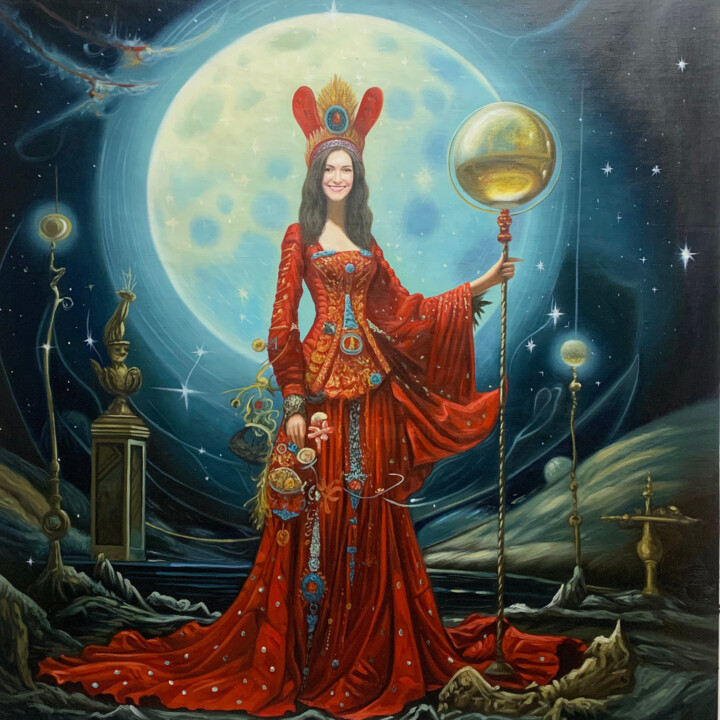
©2023 Dr. Magdalena Laabs
Origins and history of contemporary art
The story of contemporary art unfolds in the mid-20th century, marked by seismic shifts in artistic expression. Post-World War II, around the 1950s and 1960s, artists began experimenting beyond traditional confines, challenging the norms of what art could be. This revolutionary epoch birthed myriad new movements and artistic forms such as abstract expressionism, pop art, and minimalism. Paintings, once confined by realism, embraced abstraction, as artists used color and form to express emotions and ideas. Notable periods like the advent of pop art in the late 1950s and early 1960s saw artworks mimicking popular culture and mass media, reflecting society’s shifting focus.
The sculptural arts, too, witnessed a metamorphosis. Sculptors started to experiment with new materials and forms, often creating artworks that interacted with the viewer and the surrounding space, fostering a sense of engagement. Drawing, a timeless practice, also evolved, with artists incorporating innovative techniques and concepts to redefine its role in contemporary art.
Photography, a relatively new medium, emerged as a powerful tool in the contemporary art landscape. Born in the 19th century, it truly came into its own in the latter half of the 20th century, blurring the lines between fine art and documentation. Printmaking, a practice dating back to ancient times, saw renewed interest and experimentation with techniques like lithography, etching, and screen printing gaining prominence.
The realm of textile art expanded dramatically, as artists began to appreciate the versatility and tactile quality of fabric and fibers. Artists began using textiles to challenge the boundaries between fine art, craft, and design.
The dawn of digital technology in the late 20th century heralded a new age for contemporary art. Digital art emerged as artists started leveraging new technologies to create immersive, interactive experiences, often blurring the line between the virtual and the physical world.
Through these transformative periods, the essence of contemporary art has remained the same: a dynamic, evolving reflection of the times we live in, continually pushing boundaries and embracing the new, always questioning, always exploring.

©2023 Bernard Simunovic Artist represented by Unikarts Gallery
Evolutions of theses contemporary works in the art market
As we navigate through the 21st century, the dynamic landscape of contemporary art continues to evolve and expand, reflecting our ever-changing world. Contemporary paintings, once primarily confined to two-dimensional canvases, now embrace a multitude of forms and techniques, ranging from mixed media installations to digital creations, each piece a rich a weaving of thoughts, emotions, and narratives. Sculpture, too, has ventured far beyond traditional stone and bronze, with artists incorporating light, sound, and even motion, embodying the ephemerality and flux of the modern world.
Photography, in the hands of Contemporary Artists, has expanded its horizons, seamlessly blending with digital technology to create breathtaking imagery that challenges our perception of reality. Drawing, as well, has transcended the borders of paper, incorporating multimedia elements and exploratory techniques to redefine its role in the artistic discourse. Printmaking continues to flourish, with contemporary artists using traditional methods in innovative ways to deliver potent social and personal commentaries.
Textile art, once considered a craft, now holds a prominent place in the contemporary art world, with artists using it to explore issues of identity, tradition, and cultural heritage. Meanwhile, digital art, the newest member of the contemporary art family, has revolutionized the way we create and interact with art, presenting immersive experiences that blur the boundary between the virtual and the physical.
These diverse forms of contemporary art hold significant value in the current art market, not only due to their aesthetic appeal but also their ability to encapsulate and communicate complex ideas and emotions. Collectors, curators, and art lovers worldwide seek these works, drawn to their inherent dynamism, their innovative use of materials, and their eloquent expressions of our shared human experience. As a testimonial to our times, these contemporary artworks encapsulate the pulse of our society and the resonance of individual voices, forever etching our collective narrative into the annals of art history.
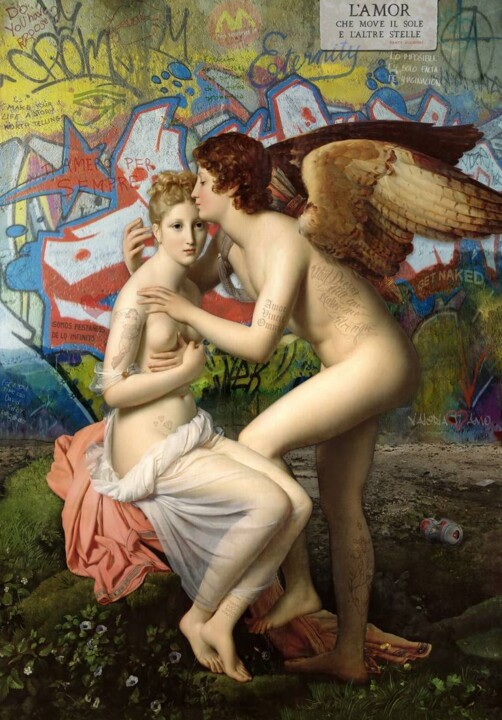
©2024 Marco Battaglini
Famous Contemporary Artists
As we delve into the vibrant realm of contemporary art, we encounter an array of artists who shape this dynamic field. Each a master in their medium - painting, sculpture, photography, drawing, printmaking, textile, or digital art - they push artistic boundaries, reflecting our era and challenging perceptions. Let’s explore these remarkable contributors and their groundbreaking works.
1. Gerhard Richter - Known for his multi-faceted approach to painting, Richter challenges the boundaries of the medium, masterfully oscillating between abstract and photorealistic styles. His works, whether featuring squeegee-pulled pigments or blurred photographic images, engage in a fascinating dialogue with perception.
2. Jeff Koons - A significant figure in contemporary sculpture, Koons crafts monumental pieces that explore themes of consumerism, taste, and popular culture. His iconic balloon animals, constructed in mirror-polished stainless steel, captivate with their playful yet profound commentary.
3. Cindy Sherman - An acclaimed photographer, Sherman uses her lens to explore identity and societal roles, particularly of women. Renowned for her conceptual self-portraits, she assumes myriad characters, pushing the boundaries of photography as a medium of artistic expression.
4. David Hockney - Hockney, with his prolific output spanning six decades, is a pivotal figure in contemporary drawing. His bold use of color and playful exploration of perspective convey an intoxicating sense of joy and an unabashed celebration of life.
5. Kiki Smith - An innovative printmaker, Smith’s work explores the human condition, particularly the female body and its social and cultural connotations. Her etchings and lithographs speak to universal experiences of life, death, and transformation.
6. El Anatsui - A master of textile art, Anatsui creates stunning tapestry-like installations from discarded bottle caps and aluminum scraps. These shimmering, flexible sculptures blend traditional African aesthetic with contemporary art sensibilities, speaking to themes of consumption, waste, and the interconnectedness of our world.
7. Rafael Lozano-Hemmer - A leading figure in digital art, Lozano-Hemmer utilizes technology to create interactive installations that blend architecture and performance art. His work, often participatory in nature, explores themes of surveillance, privacy, and the relationship between people and their environments.

©2024 Escritor Irineu Correia
Notable contemporary artworks
The contemporary art landscape is a dynamic patchwork of diverse expressions and groundbreaking ideas, each artwork a unique dialog with its audience. Here are a selection of some renowned contemporary artworks, spanning various media such as painting, sculpture, photography, drawing, printmaking, textile art, and digital art, that have profoundly influenced this vibrant movement.
"Cloud Gate" by Anish Kapoor, 2006 - This monumental stainless steel sculpture, also known as "The Bean," mirrors and distorts the Chicago skyline and onlookers in its seamless, liquid-like surface, creating an interactive experience that blurs the line between the artwork and the viewer.
"Marilyn Diptych" by Andy Warhol, 1962 - An iconic piece of pop art, this silkscreen painting features fifty images of Marilyn Monroe. Half brightly colored, half in black and white, it reflects the dichotomy of celebrity life and its influence on popular culture.
"Rhein II" by Andreas Gursky, 1999 - This photographic artwork, a digitally-altered image of the Rhine River, is celebrated for its minimalist aesthetic. It strips the landscape to its bare essentials, invoking a sense of tranquility and vastness.
"Black Square" by Kazimir Malevich, 1915 - A revolutionary painting in the realm of abstract art, this piece, featuring nothing more than a black square on a white field, challenges traditional notions of representation, symbolizing a new era in artistic expression.
"Puppy" by Jeff Koons, 1992 - This giant sculpture, a West Highland Terrier blanketed in flowering plants, explores themes of innocence, consumer culture, and the interplay between high art and kitsch. It’s a delightful blend of traditional sculpture and garden craft.
"Re-projection: Hoerengracht" by Ed and Nancy Kienholz, 1983-1988 - A room-sized tableau representing Amsterdam’s red-light district, this work combines elements of sculpture, painting, lighting, and found objects. It engages viewers in a stark commentary on commodification and objectification.
"Untitled" (Your body is a battleground) by Barbara Kruger, 1989 - This photomontage, combining black-and-white photography with impactful text, explores issues of feminism, identity, and power. Its potent, confrontational message is a prime example of the power of text in contemporary visual art.
"For the Love of God" by Damien Hirst, 2007 - This sculpture, a platinum cast of a human skull encrusted with 8,601 diamonds, probes themes of mortality, value, and the human fascination with luxury and decadence. It’s a compelling blend of macabre and magnificence.
"Physical impossibility of Death in the Mind of Someone Living" by Damien Hirst, 1991 - This artwork, featuring a tiger shark preserved in formaldehyde, blurs the line between traditional sculpture and biological specimen. It prompts viewers to contemplate mortality and nature’s ferocity.
"One and Three Chairs" by Joseph Kosuth, 1965 - A piece of conceptual art, it presents a physical chair, a photograph of a chair, and a dictionary definition of a chair, thus exploring the relationship between language, picture, and referent in art.
These pieces, in their diversity, exemplify the rich tapestry of contemporary art, each piece a unique commentary on our world and a testament to the limitless potential of creative expression.
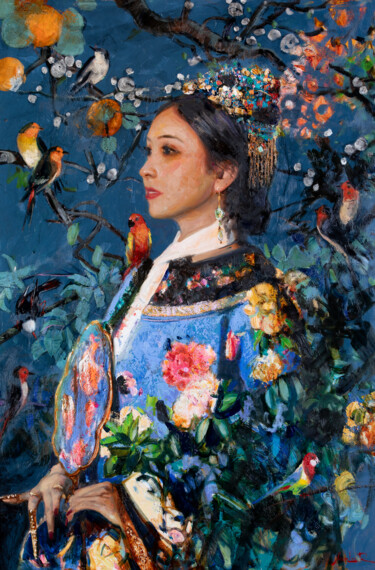
Khanlar Asadullayev
Oil on Canvas | 119.9x79.8 cm
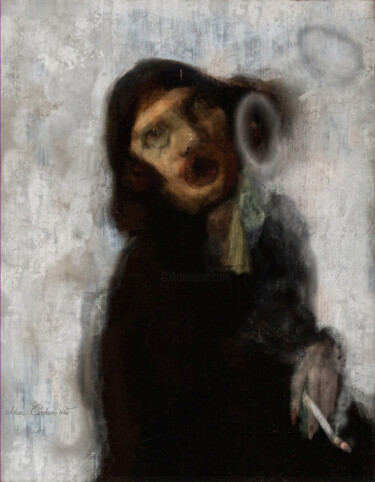
Adam Czekański
Oil on Linen Canvas | 110x90 cm

Oberlin The Artist
Acrylic on Canvas | 40.6x30.5 cm

Emiondi Olivais (Emiondi)
Digital Photography on Other substrate | 130x130 cm
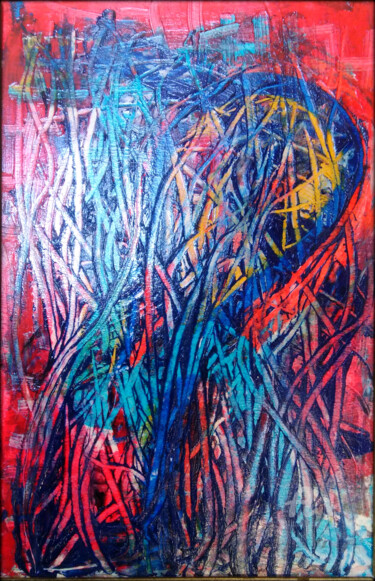
Jean Philippe Desmoulins
Oil on Paper | 40x28 cm
